Salesforce Vlocity Product Mapping Training
Salesforce Vlocity for Seamless Product Design
Salesforce Vlocity can assist in the systematic definition of products. Firstly, creating a checklist is an essential step in maintaining accuracy when building out product structures, as it is key to maintaining accuracy in this regard.
Without this tool, structuring attributes and object types could become unruly and chaotic. One key benefit of Salesforce Vlocity is the ability to work with picklists.
For instance, when designing wearable devices, picklists can help select attributes like style, colour, and band type with excellent efficiency.
A feature like a Midnight Aluminium finish or a Stainless Steel variant as part of our design to truly distinguish our product truly. It’s all part of making our product truly distinctive.
Consistency between clients providing product specifications and Salesforce Vlocity’s configuration process is crucial to maintain valid and effective data that complies with industry standards and fosters clarity and compliance with client preferences.

Salesforce Vlocity makes this process efficient while minimising errors during this phase of our configurations.
Salesforce Vlocity’s ability to assign images to picklist items makes product visualisation clearer; when users select Midnight Aluminium variants, their respective images appear instantly, enhancing user experience and improving the overall user journey.
This process illustrates how Salesforce Vlocity transforms product design. By optimising configurations and ensuring consistency across the workflow, Salesforce Vlocity enables smooth product configuration processes that reduce wasteful activities, such as managing attributes or aligning best practices.
Salesforce Vlocity serves as an indispensable solution to ensure efficient product configuration processes.
Product Modelling in Salesforce Vlocity
Salesforce Vlocity will allow me to conduct product modelling. To set up bundles, review auto-capture behaviours and investigate object interactions more thoroughly.
Salesforce Vlocity provides a solid foundation for building scalable product offerings.
From creating bundles and assigning attributes to configuring layout rules, Salesforce Vlocity adapts perfectly to real-life business situations.
Defining Object Types in Salesforce Vlocity
Salesforce Vlocity’s object types help us categorise products effectively. Each object type—be it a mobile device, smartwatch, or any other product—contains attributes and fields that define its specifications.
Utilising object types within Salesforce Vlocity enables users to streamline searches and filter relevant information effortlessly, improving usability while ensuring customers can quickly access what they need.
Salesforce Vlocity’s set-up relies heavily on object types as its foundation. Whether it’s for creating smartphones or smartwatches, Salesforce Vlocity enables the assignment of inherited attributes, streamlining the creation process.
By leveraging predefined attributes, product definition can become significantly faster without requiring tedious manual labour.
Object Types for Bundles in Salesforce Vlocity
Bundling in Salesforce Vlocity is straightforward once you know which object type to use. Usually opt for the Offer Special type when packaging multiple products as a single offer.
This makes scaling configurations and creating complex deals easy without interfering with product definitions.
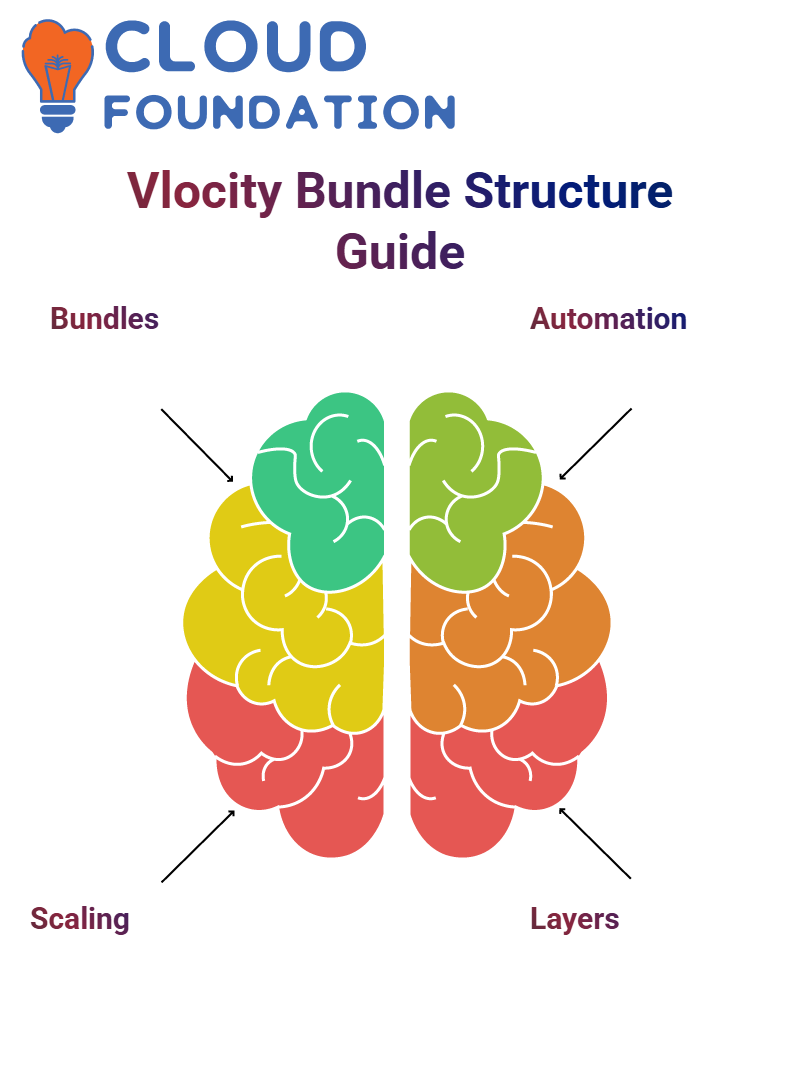 Salesforce Vlocity makes handling these bundles efficient when working with commercial product structures, offering the platform the capability to take over all the heavy lifting from there on out. Establish the ideal structure.
Salesforce Vlocity makes handling these bundles efficient when working with commercial product structures, offering the platform the capability to take over all the heavy lifting from there on out. Establish the ideal structure.
Multi-Layer Product Structure in Salesforce Vlocity
Salesforce Vlocity features a multi-layered product structure designed for seamless transitions.
By integrating services, technical products, and resources, we ensure the complete functionality of this layered approach, which supports broadband configurations such as DSL or fibre-optic networks.
By selecting DSL services in Salesforce Vlocity, we configure resources that maximise connectivity. The decomposition matrix serves a vital function by assigning mappings properly, making our network highly scalable and cost-effective.
Defining Marketing Data in Salesforce Vlocity
Salesforce Vlocity simplifies data marking by seamlessly incorporating values into technical assignments.
Every attribute within a service product is directly linked to the resources assigned for execution, ensuring clarity and structure during its creation and maintenance.
As we update and refine our datasets, Salesforce Vlocity provides us with a robust framework for making meaningful links between attributes and assigned products.
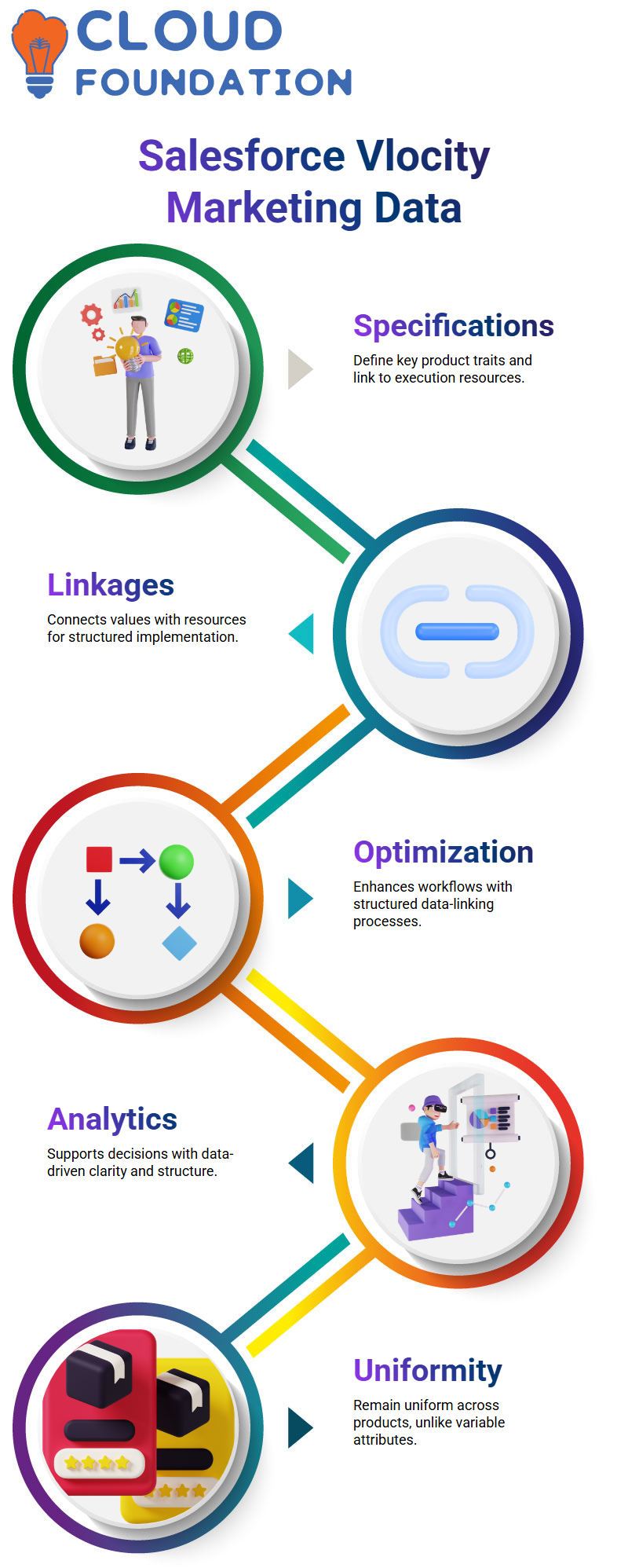
This structured approach enhances operational efficiency while guaranteeing every decision is supported by data-driven insights.
The Role of Attributes in Salesforce Vlocity
Attributes play a crucial role in Salesforce Vlocity. When assigning values to products, attributes determine their characteristics.
For instance, when dealing with colours, they do not represent one specific attribute; instead, there are pre-selected colours available as pickable values that define their characteristics.
Understanding the difference between fields and attributes is crucial; fields remain consistent across products, while attributes depend on each specific one, ensuring we assign values correctly within Salesforce Vlocity.
Mapping Attributes in Salesforce Vlocity
Salesforce Vlocity’s mapping capabilities enable us to transfer data between various attributes quickly and efficiently. When working with mapping types, it is essential to understand how values are assigned and transferred between attributes.
Previously, Salesforce Vlocity mappings provided different values automatically; now, however, users have greater freedom in customising these mappings themselves for increased control over attribute transformations.
If we need to assign values manually, we have precise control over them. Salesforce Vlocity thus becomes an indispensable resource when managing attribute transformations.
Salesforce Vlocity allows users to define specific attributes for individual products.
Salesforce Vlocity provides users with the tools to map these distinct traits onto service products, ensuring that each item sold in-store or online maintains its unique characteristics.
Technical attributes in Salesforce Vlocity differ significantly from commercial product attributes in that technical products only contain attributes, while commercial items include both attributes and fields for customisation purposes.
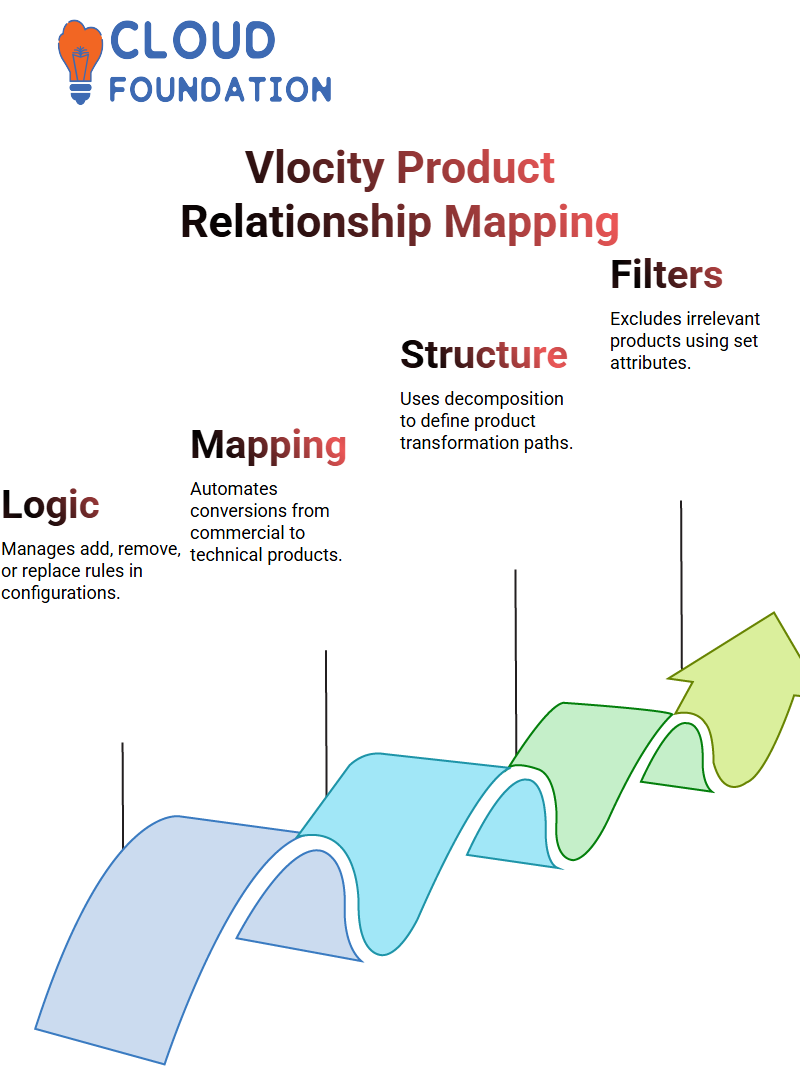
This distinction helps maintain accurate product configurations while streamlining the order processing process.
Salesforce Vlocity Filters
Salesforce Vlocity and how filters help us narrow down product selections. Filters play a crucial role in determining when a rule should be triggered.
To auto-add items through Salesforce Vlocity; no longer do you have to add each one individually by hand, as opposed to manually adding them through automated conditions.
One key benefit of Salesforce Vlocity lies in its filter capabilities, which allow us to set predetermined conditions based on rules we configure.
These rules execute only when specific criteria have been fulfilled, ensuring that users are shown products suited to their preferences.
Additionally, products that may otherwise go unnoticed are suggested or excluded based on user preferences.
Salesforce Vlocity Product Relationships
Salesforce Vlocity provides powerful tools for managing product relationships, ensuring seamless compatibility and automation in product selection.
When configuring products, we must determine their interactions — whether to add, remove, or replace — based on customer selections, to ensure a seamless configuration experience.
Salesforce Vlocity simplifies product management by automating the conversion of commercial products into technical ones.
When adding an item to the cart, Salesforce Vlocity ensures it is correctly mapped without requiring manual intervention, streamlining the ordering process while eliminating unnecessary steps.
Decomposition relationships play a pivotal role in Salesforce Vlocity for structuring product structures. If a product is not added to a decomposition relationship, it may not convert to a technical product form upon order submission.
Thus, mapping provides assurances that appropriate technical attributes will be assigned for every item made more efficient by this process.
Product Recommendations with Salesforce Vlocity
Salesforce Vlocity’s recommendation engine has been carefully tailored to offer intelligent suggestions to our users, without sending products that don’t belong in their collection of relevant items.
Instead, we refine these suggestions by applying exclusion rules to product relationships, ensuring that optimal recommendations are made.
Utilising Salesforce Vlocity filters, we can exclude specific products based on attributes such as price, speed, or purchase type, ensuring customers see only relevant items in their cart.
Compatibility Rules in Salesforce Vlocity
Compatibility rules in Salesforce Vlocity help verify product relationships by validating that only compatible items are added to a cart.
They act as configuration tools by creating criteria for product selection based on predetermined conditions.

Salesforce Vlocity can ensure that incompatible items are removed from an office internet solution to avoid errors and enhance product recommendations with greater accuracy. This prevents mistakes while improving accuracy.
Order Capture in Salesforce Vlocity
Order capture is at the core of Salesforce Vlocity’s offering, featuring an intuitive user interface for rapid product addition, order submission, and real-time asset generation, providing complete transparency into how changes affect system-wide systems.
Instead of devoting too much time and energy to one section, prefer to provide concise and clear examples that illustrate its points effectively.
A powerful demonstration makes information much simpler to absorb.
Templates in Salesforce Vlocity
Templates play an invaluable role in Salesforce Vlocity when it comes to efficiently outlining outputs. Templates ensure consistency among orders and help to streamline operations, saving both time and resources.
During, mapping different elements to products using field maps is an incredible time-saver, significantly reducing manual effort.
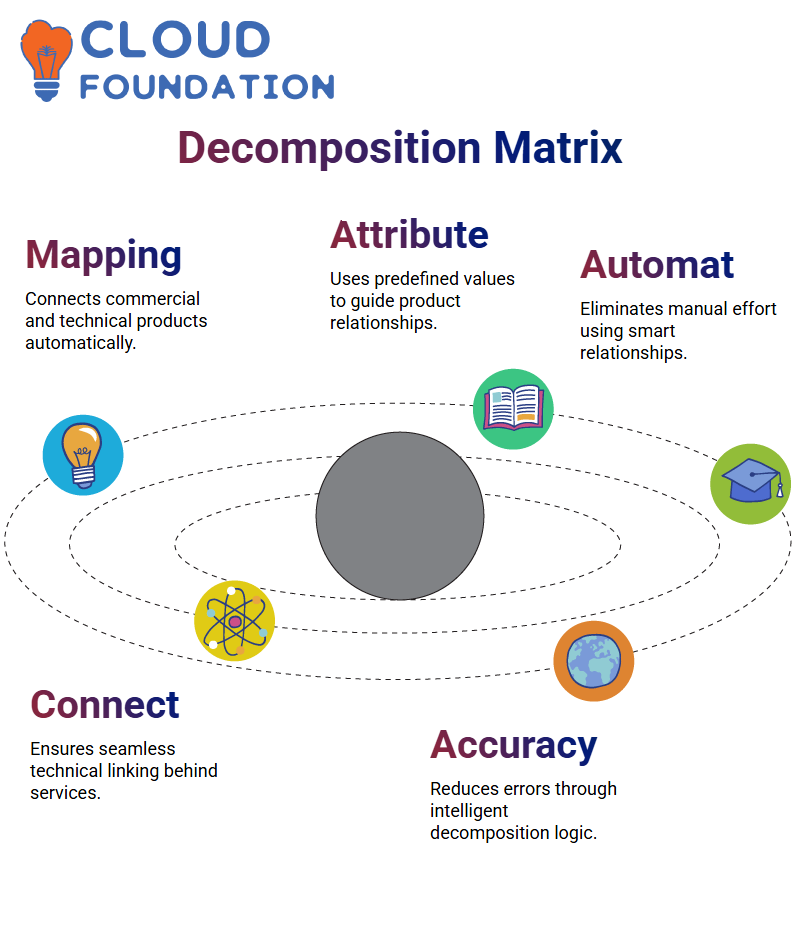 Salesforce Vlocity allows seamless mapping while significantly cutting manual effort requirements.
Salesforce Vlocity allows seamless mapping while significantly cutting manual effort requirements.
Product Decomposition in Salesforce Vlocity
Product decomposition plays a central role in Salesforce Vlocity, transforming commercial products into technical ones.
When connecting a product, its technical specifications usually need to match seamlessly; however, some products, such as phone cases, don’t require technical specifications, so we only need to consider commercial aspects when connecting.
Salesforce Vlocity’s offer bundling and grouping tools focus on commercial attributes rather than technical ones, to optimise categorisation for efficient processing of product relationships.
The Role of Decomposition Matrix in Salesforce Vlocity
One of the most valuable features in Salesforce Vlocity is the decomposition matrix.
This matrix enables us to map multiple commercial products to their corresponding technical products by predefining attributes, eliminating the need for manual relationship creation and facilitating the easier decomposition of Salesforce Vlocity data.
Assume, for example, that we’re offering broadband connections: a customer can see the speed and price, but behind the scenes, Salesforce Vlocity manages technical components like network protocols and infrastructure dependencies – even decomposition matrices help link commercial products with technical ones seamlessly.
Decomposition Relationships with Salesforce Vlocity
Salesforce Vlocity enables us to link commercial products with technical ones using attributes easily.

Instead of manually assigning values, decomposition relationships will allow us to automate linking based on predetermined conditions, removing tedious manual mapping steps while ensuring accuracy.
Salesforce Vlocity simplifies setting up high-speed internet service by storing matrix data that specifies how each product behaves under various scenarios and decomposing rules to facilitate seamless connectivity between commercial products and technical services.
Mapping Types in Salesforce Vlocity
Salesforce Vlocity supports various mapping types, including static, ad verbatim and list mappings. Static assigns direct values directly from source values, while ad verbatim copies them from source to destination without modification.
List mapping, on the other hand, transforms source values into destination values, allowing for flexible product configuration.
Mapping rules in Salesforce Vlocity ensure that technical attributes are correctly assigned to products.
Without it, products might appear incorrectly within the system, with user-defined mapping rules providing consistency and accuracy across product relationships.
Mapping Services in Salesforce Vlocity
One of the powerful features in Salesforce Vlocity is its ability to map services with resources.
When configuring broadband speed options, fibre cables are assigned based on their technical attributes, ensuring precise alignment between commercial products and service offerings.
Decomposition matrix technology in Salesforce Vlocity enables us to establish relationships among technical and resource products, creating crucial links in network architecture that provide services such as VDSL or ADSL, with clear roles defined for every component.
Optimising Product Lifecycle in Salesforce Vlocity
As products evolve, their attributes may change, although certain features should remain consistent. Within Salesforce Vlocity, we can exclude specific characteristics from the basket cache to retain their original values and ensure continuity for customers.
As with phone IMEI numbers, Salesforce Vlocity enables the preservation of these numbers even through multiple software upgrades on individual product versions.
Decision Matrices in Salesforce Vlocity
Decision matrices in Salesforce Vlocity play a crucial role in product allocation. We use them to define mapping rules between source and destination products.
When someone purchases a broadband plan from us, Salesforce Vlocity automatically assigns the appropriate technical resources.
Decision matrices simplify product setup processes by eliminating manual data entry errors, streamlining setup efficiently, and ensuring accuracy.
This ensures that attributes like speed limits and traffic codes are applied accurately without manual intervention.
Data Securing in Salesforce Vlocity
Salesforce Vlocity takes data security very seriously, with encryption serving to protect sensitive information in much the same manner as WhatsApp’s end-to-end encryption or ATM transactions, preventing unintended access.
Salesforce Vlocity features encryption of attributes, such as IMEI numbers, to protect vital information even during product upgrades or modifications.
Automating Product Mapping in Salesforce Vlocity
Once, decomposition relationships were assigned manually; now, with Salesforce Vlocity, automation takes centre stage.
We can define conditions and attributes to automatically assign technical products, ensuring efficiency and accuracy in product assignment.
For instance, consider multiple broadband service offerings with individual backend configuration requirements.
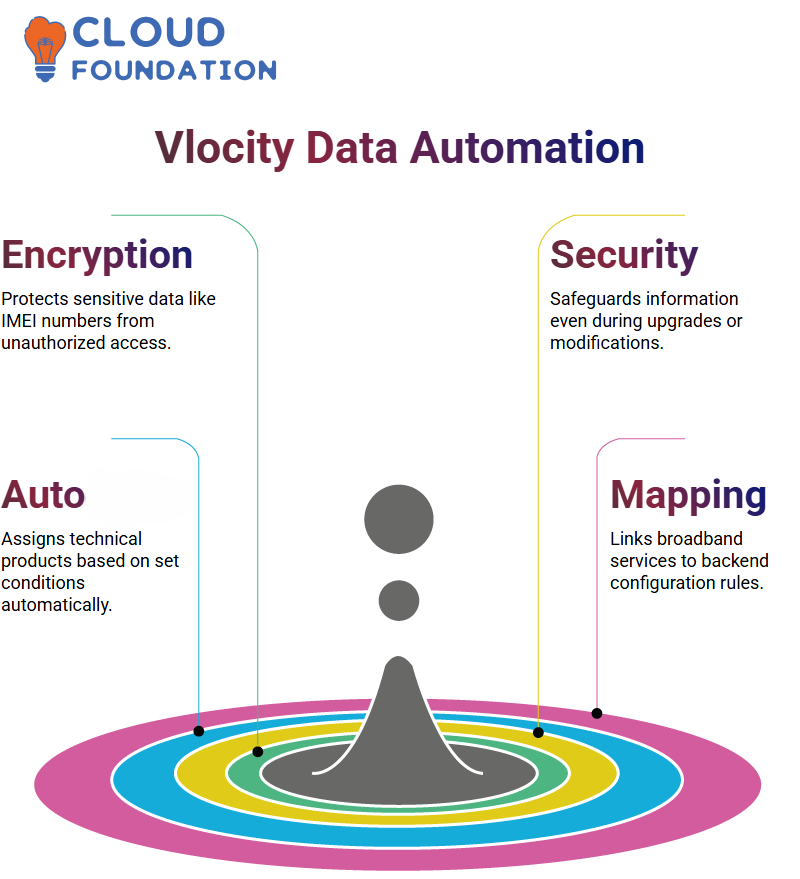
Salesforce Vlocity simplifies this process by utilising a decomposition matrix to dynamically map these attributes, ensuring they are used appropriately and meeting the technical specifications for each service plan option.
Resource Management in Salesforce Vlocity
Salesforce Vlocity efficiently coordinates resources. From fibre optic cables, copper wires, and broadband infrastructure to product-specific technical components, it assigns each one according to the product’s requirements.
Salesforce Vlocity’s automated resource management ensures that replacement components are readily available in the event of technical difficulties, minimising disruptions while maintaining service quality without requiring manual adjustments.

Vinitha Indhukuri
Author



